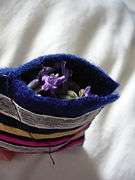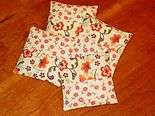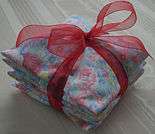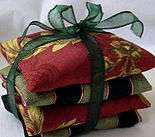Sachet
A sachet /ˈsæʃeɪ/ is a small scented cloth bag filled with herbs, potpourri, or aromatic ingredients.[1][2][3][4][5] A sachet is also a small porous bag or packet containing a material intended to interact with its atmosphere; for example, desiccants are usually packed in sachets which are then placed in larger packages.
| Look up sachet in Wiktionary, the free dictionary. |

A sachet can be defined as a small soft bag containing perfumed or sweet-smelling items also referred to as an ascent bag, scent bag, sweet bag, sachet bag, sachet de senteurs, spiced sachet, potpourri sachet, scented sachet, perfume cushion, smelling cushion, scented cushion, fragrant bag, pomander and "dream pillow."[6][7][8][9][10][11]
Cultural history
During the Chinese Warring States period a scented sachet was an ornament worn on the body and used to absorb sweat, repel insects and ward off evils.[11] In the Han Dynasty both boys and girls wore sachets and in the Tang Dynasty and Song Dynasty scented bags gradually became preferred only by women.[11] A scented sachet became a love token in the Qing Dynasty.[11]
In medieval Europe the sachet was known as a "plague-bag". These were generally worn around the neck, or dangled from the waist. It was believed that they provided protection against parasites and miasmata. These "sachets" contained sweet powders, aromatic calamus, benzoin, storax, galingale, cloves, and other fragrances from a herb or flower garden.[12]
Queen Isabella of Spain used fragrant sachets consisting of dried rose and carnation petals, orris and calamus root, and other ingredients like powdered coriander seeds.[13] In the nineteenth century a sachet filled with hops was called a "Pulvinar Humuli" and used by George III of Great Britain and Prince Albert of Saxe-Coburg to help induce sleep.[14]
In modern times, a small cloth bag filled with potpourri may be laid among garments in a dresser.[15]
In various Indian cuisines, a "potli bag" is used to contain whole spices, so that they may be easily separated from the food after cooking. They are also used as fashion ornaments unto themselves.
Uses
Scented sachets are for containing odorous substances to be laid among handkerchiefs to perfume them. They are also used to make undergarments and outer garments sweet smelling as well as placed amongst linens.[16] Scented sachets are also hung in closets and cupboards. They are also put into briefcases and luggage. Some are used in stationary packets and others are put under pillows to help one sleep.[12] Scented sachets are "sweet bags" (an old name for a small sachet cloth bag) and are put in automobiles, clothes dryers, clothes closets, inside or about children's stuffed animals, on the backs of chairs, and on doorknobs.[17] Sachets with herbs like hops and lavender act as a sedative.[18] These type of sachets are often put in closets and dresser drawers for their scents.[19] The word has also been used to mean a small bag of any material, e.g., paper, foil, or plastic, used to package doses of medication, for example, sleeping powders.
Some "dream pillow" types of scented sachets (i.e. "hop pillows") are made with sleep inducing ingredients like hops, chamomile, valerian, skullcap, and lavender that help promote sleep.[10][20][21][22][23][24] These scented sachets of aromatic herbs are also referred to as "herb pillows" or "sleep pillows" and are designed to overcome sleeplessness.[25][26][27][28][29][30]
Ram's 1606 booklet Little Dodoen gave a sachet formula to take to bed to help one sleep:
Take dry rose leaves keep them in a glass which will keep them sweet and then take powder of mints, powder of cloves in a grosse powder. Put the same to the Rose leaves then put all these together in a bag and take that to bed with you and it will cause you to sleep, and it is good to smell unto at other times.[31]
Certain herbs used in these type sachet "sleep pillows", like hops, have a soporific and a slight narcotic effect.[32] These herb filled sachets are even called "dreamtime pillows".[33] There are formulas using rosemary seeds to fill sachets and these are to be hung in a bedroom to promote sleep.[32] The traditional method to treat insomnia with herb filled sachets of hops or lavender is to place them in, under or near your sleeping pillow.[34][35][36][37][38] The "dream pillow" or "sleep pillow" sachet concept has been used for decades to help overcome sleeplessness.[39] These "sleep pillows" have a therapeutic effect and hops as an ingredient to this type of sachet are considered best at inducing sleep.[40] One type of "sleep pillow" sachet recipe by herb and flower author Penny Black calls for violets, rose petals, rosemary, tonka bean, vanilla bean, and a drop of lemon oil.[41]
Types
Scented sachets are many times homemade and come in many sizes, styles, shapes and fragrances. A typical size would be approximately 4 inches square or thereabouts - some as small as a one-inch ball and others as large as an 8 inch square.[10] Many are in the shape of a plump little pillow.[42] The potpourri mix put inside the sachet can be herbal items or flower parts.[43] Some sachets that are made from spices like allspice, aniseed, cinnamon, cloves, nutmeg, and vanilla beans are referred to as "spiced sachets."[44] A scented sachet used as a pot holder that is stuffed with allspice, cinnamon and cloves will release an apple pie smell when a hot dish is put on it.[10]
Other scented sachets are made from the winter savory, lavender, rosemary, tops of hyssop, chippings of cassia ligna, cedar, and sassafras.[45] This type is not only used to make garments sweet smelling but keep away destructive insects and worms.[46] Sachets with dried moth-repellent herbs like wormwood, southernwood, costmary, lavender, pennyroyal, lemon verbena rosemary, rue, sage and tansy are called "moth bags."[5][47]
A sachet base can be made where you can add certain aromatic or perfumed oils later to make various sachets. Some types of sachets are called "Patchouli Sachet" (that goes with woolens and blankets); "Florida Sachet" (which ingredients are fruity); "Oakasia Sachet"; "Orange-rose Sachet"; and "Sweet Bag of linen".[48] Some scented sachets even have names like ""Heliotrope Sachet" and "Tonka Bean Sachet." [49] Others still are called "Provencal pillows", "Country pillows" and "Pillows for Love".[32]
Some are even made into Sweet Bag necklaces.[50] Some are decorated with embroidery, beads, buttons, ribbons, and fancy cloth. The oldest formula printed for a list of ingredients in an America scented sacket comes from a Colonial Williamsburg book, The Compleat Housewife, published in 1742.[51]
Gallery
| Wikimedia Commons has media related to Fragrant bags. |
References
- Simmonds, p. 324
- BUREAU OF AMERICAN ETHNOLOGY, p. 86
- Duff, p. 34
- Online Etymology Dictionary. "small perfumed bag," 1838, from Fr. sachet (12c.), dim. of sac (see sac). A reborrowing of a word that had been used 15c. in the sense "small bag, wallet."
- Oster, p. 54
- Hunter, p. 4080
- Sweringen, p. 341
- Gasc, p. 500
- Tibbins, p. 943
- Natural Remedies
- Cultural China Archived 2010-08-22 at the Wayback Machine
- Hemphill, pp. 24-26
- Garland, p. 223
- Gutenberg ebook Herbal Simples Approved for Modern Uses of Cure
- Merriam-Webster definition
- Fettner, p. 91
- Booth, p. 121
- Buchanan, pp. 322, 333
- Sisko, p. 31
- Garland, p. 268 Pillows stuffed with dried hops are an old treatment for insomnia.
- Chopra, p. 40 A sachet of hops is traditionally placed under a child's pillow to deliver sleep-inducing aromatherapy.
- Lust, p. 370 A small pillow filled with dried hops and slept on is a well-known folk remedy in many European countries for inducing a calm, restful sleep.
- How To Make Herbal Pot-Pourris, Sachets And Pillows
- Here's How To Make a Dream Pillow Dream pillows are used to promote restful sleep and pleasant dreams. They are small and flat, placed in a standard pillow, and stuffed with a sachet of calming and sleep-inducing dried herbs... George Washington reportedly used one filled with hops...
- Walter, p. 123 The "herb pillows" of the eighteenth and nineteenth centuries (little sacks of aromatic herbs thought to be a remedy for sleeplessness) always included lavender, clovepinks and costmary as principal ingredients.
- White, p. 111 There are several herbs that have a reputation for easing insomnia, and by creating a blend of these leaves and flowers, you can make small "herb pillows" to help you sleep.
- Murphy-Hiscock, p. 159 Sweet Dream Pillow - This pillow is designed to encourage relaxation and soothe restless sleep.
- Dream Pillows
- Making herbal pillows
- Dream Pillows
- Rohde, p. 29
- Garland, p. 229
- Knapp, p. 61
- Calbom, p. 211
- Williamson, p. 191
- Mitrea, p. 31
- Kothe, p. 46
- Foster, p. 212
- Bond, p. 265
- Oster, p. 55
- Black, p. 66
- Black, p. 96
- Black, pp. 57-71
- Seton, p. 54
- Freeman, p. 172
- Cox, p. 259
- Garland, p. 222
- Strobell, p. 139
- Freeman, p. 173
- Cox, p. 279
- Fettner, p. 95
Sources
- Black, Penny, The book of potpourri: fragrant flower mixes for scenting & decorating the home, Simon and Schuster, 1989, ISBN 0-671-68210-5
- Bond, Annie B., Home Enlightenment: Practical, Earth-Friendly Advice for Creating a Nurturing, Healthy, and Toxin-Free Home and Lifestyle, Rodale, 2005, ISBN 1-57954-811-3
- Booth, Nancy M., Perfumes, splashes & colognes: discovering & crafting your personal fragrances, Storey Publishing, 1997, ISBN 0-88266-985-0
- Buchanan, Rita, Taylor's guide to herbs, Houghton Mifflin, 1995, ISBN 0-395-68081-6
- BUREAU OF AMERICAN ETHNOLOGY, published 1930
- Calbom, Cherie, The Juice Lady's Guide to Juicing for Health, Avery, 2000, ISBN 0-89529-999-2
- Chopra, Deepak, A sachet of hops is traditionally placed under a child's pillow to deliver sleep-inducing aromatherapy., Random House, Inc., 2000, ISBN 0-609-80390-5
- Cox, Janice, Natural beauty from the garden: more than 200 do-it-yourself beauty recipes and garden ideas, Macmillan, 1999, ISBN 0-8050-5781-1
- Duff, Gail, Natural Fragrances: Outdoor Scents for Indoor Uses, Storey Publishing, LLC, 1991, ISBN 0-88266-683-5
- Fettner, Ann Tucker, Potpourri, incense, and other fragrant concoctions, Workman Pub. Co., 1977, ISBN 0-911104-97-6
- Fleming Charles, Royal dictionary, English and French and French and English, Volume 2, Firmin-Didot and Company, 1885
- Foster, Steven, National Geographic Desk Reference to Nature's Medicine, National Geographic Books, 2008, ISBN 1-4262-0293-8
- Freeman, Sally, Ageless Natural Beauty, Barnes & Noble Publishing, 2002, ISBN 0-7607-3373-2
- Garland, Sarah, The Complete Book of Herbs and Spices, frances lincoln ltd, 2004, ISBN 0-7112-2374-2
- Gasc, Ferdinand E. A., Dictionary of the French and English languages: with more than fifteen thousand new words, meanings, etc.., H. Holt and Company, 1876
- Hemphill, Rosemary, Fragrance and flavour: the growing and use of herbs, Angus and Robertson, 1960, Pennsylvania State University
- Hills, William Henry, The Writer, Volume 6, The Writer, 1893
- Hunter, Robert, Universal dictionary of the English language: a new and original work presenting for convenient reference the orthography, pronunciation, meaning, use, origin and development of every word in the English language ..., P. F. Collier, 1897
- Knapp, Jennifer, Beauty Magic: 101 Recipes, Spells, and Secrets , Chronicle Books, 2004, ISBN 0-8118-4222-3
- Kothe, Erika B, Jewels from Heaven , iUniverse, 2004, ISBN 0-595-31718-9
- Lust, John, The Natural Remedy Bible, Simon and Schuster, 2003, ISBN 0-7434-6642-X
- Mitrea, MD (Eur), ND Liliana Stadler, Natural medicine mosaic, Natural Medicine Books, 2007, ISBN 0-9784947-0-9
- Murphy-Hiscock, Arin, The way of the green witch: rituals, spells, and practices to bring you back to nature, Adams Media, 2006, ISBN 1-59337-500-X
- Oster, Maggie, Ortho's all about herbs, Meredith Books, 1999, ISBN 0-89721-420-X
- Pereira, Jonathan, Title The Elements of Materia Medica and Therapeutics: including notices of most of the medical substandces in use in the civilized world, and forming an Encyclopaedia of Materia Medica, Volume 1, Longman, 1854
- Rohde, Eleanour Sinclair, Rose Recipes from Olden Times, Courier Dover Publications, 1973, ISBN 0-486-22957-2
- Rose, Jeanne, Herbs & Things: Jeanne Rose's Herbal, Last Gasp, 2002, ISBN 0-86719-525-8
- Seton, Susannah, Simple Pleasures of the Home: Comforts and Crafts for Living Well, Conari, 2002, ISBN 1-57324-854-1
- Simmonds, Peter Lund, The dictionary of trade products, manufacturing, and technical terms: with a definition of the moneys, weights, and measures of all countries, G. Routledge, 1858
- Sisko, Eileen, Nature power then and now, Mason County Historical Society, 1984, ISBN 0-911377-07-7
- Strobell, Adah Parker, Like it was: Bicentennial games 'n fun handbook, Acropolis Books, 1975, ISBN 0-87491-059-5
- Sweringen, Hiram V., A dictionary of pharmaceutical science: a guide for the pharmaceutist, druggist, and physician..., P. Blakiston, 1882
- Walter, John T., hints & pinches, Hill Street Press, 2002, ISBN 1-892514-98-2
- Webster, Helen, Herbs - How to Grow Them and How to Use Them, READ BOOKS, 2008, ISBN 1-4437-3632-5
- White, Susan, Herbs Teach Yourself Book, NTC Pub. Group, 1993, ISBN 0-8442-3928-3
- Williamson, Karen, Sleep Deep: Simple Techniques for Beating Insomnia , Perigee, 2007, ISBN 0-399-53323-0











